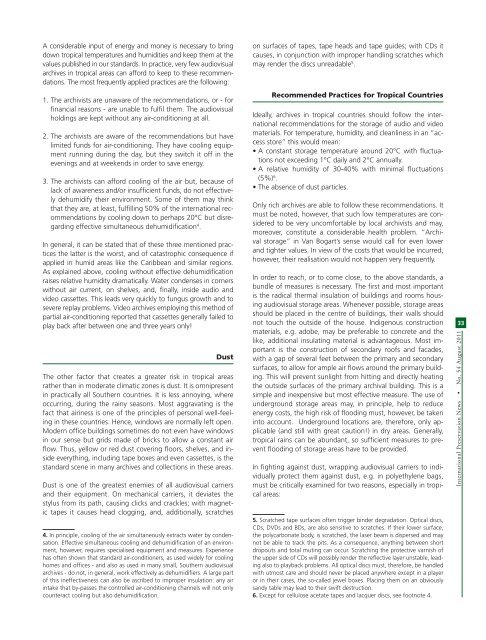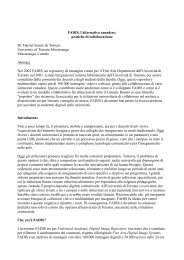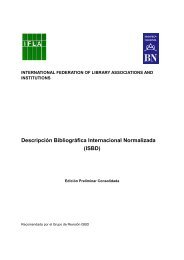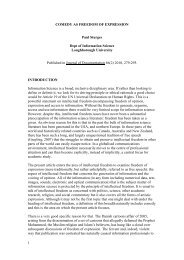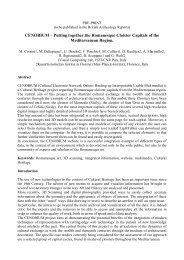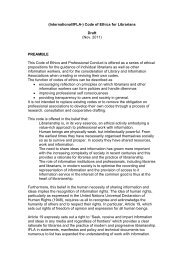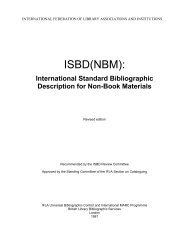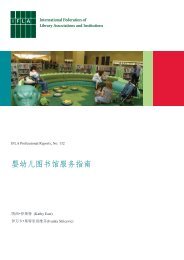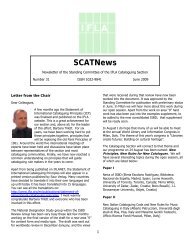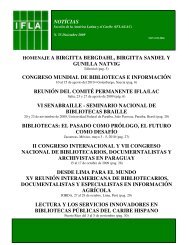N o 54 - IFLA
N o 54 - IFLA
N o 54 - IFLA
Create successful ePaper yourself
Turn your PDF publications into a flip-book with our unique Google optimized e-Paper software.
A considerable input of energy and money is necessary to bring<br />
down tropical temperatures and humidities and keep them at the<br />
values published in our standards. In practice, very few audiovisual<br />
archives in tropical areas can afford to keep to these recommendations.<br />
The most frequently applied practices are the following:<br />
1. The archivists are unaware of the recommendations, or - for<br />
financial reasons - are unable to fulfil them. The audiovisual<br />
holdings are kept without any air-conditioning at all.<br />
2. The archivists are aware of the recommendations but have<br />
limited funds for air-conditioning. They have cooling equipment<br />
running during the day, but they switch it off in the<br />
evenings and at weekends in order to save energy.<br />
3. The archivists can afford cooling of the air but, because of<br />
lack of awareness and/or insufficient funds, do not effectively<br />
dehumidify their environment. Some of them may think<br />
that they are, at least, fulfilling 50% of the international recommendations<br />
by cooling down to perhaps 20°C but disregarding<br />
effective simultaneous dehumidification 4 .<br />
In general, it can be stated that of these three mentioned practices<br />
the latter is the worst, and of catastrophic consequence if<br />
applied in humid areas like the Caribbean and similar regions.<br />
As explained above, cooling without effective dehumidification<br />
raises relative humidity dramatically. Water condenses in corners<br />
without air current, on shelves, and, finally, inside audio and<br />
video cassettes. This leads very quickly to fungus growth and to<br />
severe replay problems. Video archives employing this method of<br />
partial air-conditioning reported that cassettes generally failed to<br />
play back after between one and three years only!<br />
Dust<br />
The other factor that creates a greater risk in tropical areas<br />
rather than in moderate climatic zones is dust. It is omnipresent<br />
in practically all Southern countries. It is less annoying, where<br />
occurring, during the rainy seasons. Most aggravating is the<br />
fact that airiness is one of the principles of personal well-feeling<br />
in these countries. Hence, windows are normally left open.<br />
Modern office buildings sometimes do not even have windows<br />
in our sense but grids made of bricks to allow a constant air<br />
flow. Thus, yellow or red dust covering floors, shelves, and inside<br />
everything, including tape boxes and even cassettes, is the<br />
standard scene in many archives and collections in these areas.<br />
Dust is one of the greatest enemies of all audiovisual carriers<br />
and their equipment. On mechanical carriers, it deviates the<br />
stylus from its path, causing clicks and crackles; with magnetic<br />
tapes it causes head clogging, and, additionally, scratches<br />
4. In principle, cooling of the air simultaneously extracts water by condensation.<br />
Effective simultaneous cooling and dehumidification of an environment,<br />
however, requires specialised equipment and measures. Experience<br />
has often shown that standard air-conditioners, as used widely for cooling<br />
homes and offices - and also as used in many small, Southern audiovisual<br />
archives - do not, in general, work effectively as dehumidifiers. A large part<br />
of this ineffectiveness can also be ascribed to improper insulation: any air<br />
intake that by-passes the controlled air-conditioning channels will not only<br />
counteract cooling but also dehumidification.<br />
on surfaces of tapes, tape heads and tape guides; with CDs it<br />
causes, in conjunction with improper handling scratches which<br />
may render the discs unreadable 5 .<br />
Recommended Practices for Tropical Countries<br />
Ideally, archives in tropical countries should follow the international<br />
recommendations for the storage of audio and video<br />
materials. For temperature, humidity, and cleanliness in an “access<br />
store” this would mean:<br />
• A constant storage temperature around 20°C with fluctuations<br />
not exceeding 1°C daily and 2°C annually.<br />
• A relative humidity of 30-40% with minimal fluctuations<br />
(5%) 6 .<br />
• The absence of dust particles.<br />
Only rich archives are able to follow these recommendations. It<br />
must be noted, however, that such low temperatures are considered<br />
to be very uncomfortable by local archivists and may,<br />
moreover, constitute a considerable health problem. “Archival<br />
storage” in Van Bogart’s sense would call for even lower<br />
and tighter values. In view of the costs that would be incurred,<br />
however, their realisation would not happen very frequently.<br />
In order to reach, or to come close, to the above standards, a<br />
bundle of measures is necessary. The first and most important<br />
is the radical thermal insulation of buildings and rooms housing<br />
audiovisual storage areas. Whenever possible, storage areas<br />
should be placed in the centre of buildings, their walls should<br />
not touch the outside of the house. Indigenous construction<br />
materials, e.g. adobe, may be preferable to concrete and the<br />
like, additional insulating material is advantageous. Most important<br />
is the construction of secondary roofs and facades,<br />
with a gap of several feet between the primary and secondary<br />
surfaces, to allow for ample air flows around the primary building.<br />
This will prevent sunlight from hitting and directly heating<br />
the outside surfaces of the primary archival building. This is a<br />
simple and inexpensive but most effective measure. The use of<br />
underground storage areas may, in principle, help to reduce<br />
energy costs, the high risk of flooding must, however, be taken<br />
into account. Underground locations are, therefore, only applicable<br />
(and still with great caution!) in dry areas. Generally,<br />
tropical rains can be abundant, so sufficient measures to prevent<br />
flooding of storage areas have to be provided.<br />
In fighting against dust, wrapping audiovisual carriers to individually<br />
protect them against dust, e.g. in polyethylene bags,<br />
must be critically examined for two reasons, especially in tropical<br />
areas:<br />
5. Scratched tape surfaces often trigger binder degradation. Optical discs,<br />
CDs, DVDs and BDs, are also sensitive to scratches. If their lower surface,<br />
the polycarbonate body, is scratched, the laser beam is dispersed and may<br />
not be able to track the pits. As a consequence, anything between short<br />
dropouts and total muting can occur. Scratching the protective varnish of<br />
the upper side of CDs will possibly render the reflective layer unstable, leading<br />
also to playback problems. All optical discs must, therefore, be handled<br />
with utmost care and should never be placed anywhere except in a player<br />
or in their cases, the so-called jewel boxes. Placing them on an obviously<br />
sandy table may lead to their swift destruction.<br />
6. Except for cellulose acetate tapes and lacquer discs, see footnote 4.<br />
33<br />
International Preservation News • No. <strong>54</strong> August 2011


